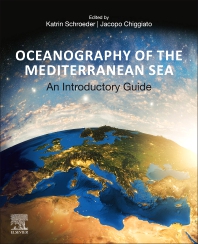Oceanography of the Mediterranean Sea: An Introductory Guide provides a comprehensive but concise introduction to the physical oceanography of the Mediterranean Sea. The book is primarily focused on the state-of-the-art understanding of the physical functioning of the Mediterranean Sea, while embracing the fundamentals of associated geological and chemical processes.

Written by multiple scientists active over many years in the Mediterranean marine community, including MEdECC Contributors, the book provides a broad overview on the information needed to get a robust background on the physical oceanography of the Mediterranean Sea for students in oceanography, climate science, marine geology and chemistry or scientists unfamiliar with the region. The book presents the existing links between climate, ocean, biogeochemical cycles and geological evolution at the Mediterranean scale, and presents clear examples of the Mediterranean region, as well as comparisons with other regions globally.
Readership: Climate scientists, general environmental scientists, oceanographers and marine scientists at graduate level and above looking for an introduction to the field or scientists in related fields looking for an introduction to this subject.
Editors: Katrin Schroeder – Consiglio Nazionale delle Ricerche-Istituto di Scienze Marine (CNR-ISMAR), Italy and Jacopo Chiggiato – Consiglio Nazionale delle Ricerche-Istituto di Scienze Marine (CNR-ISMAR), Italy
Selected content:
Chapter 3 – Mediterranean climate: past, present and future
This chapter provides an overview of the characteristics of the climate over the Mediterranean region and of the processes that determine its evolution. It describes how numerical models are used for simulating the climate at the regional Mediterranean scale, the heat, and moisture balance at Mediterranean regional scale, their relation to surface climate. The evolution of the regional climate conditions is described since the times when the Mediterranean present morphology emerged as a remnant of the Tethys Ocean. Finally, the impacts of the ongoing anthropogenic climate change are described.
Piero Lionello, Filippo Giorgi, Eelco Rohling, Richard Seager, Chapter 3 – Mediterranean climate: past, present and future, Editor(s): Katrin Schroeder, Jacopo Chiggiato, Oceanography of the Mediterranean Sea, Elsevier, 2023, Pages 41-91, ISBN 9780128236925, https://doi.org/10.1016/B978-0-12-823692-5.00011-X.
Chapter 5 – Mediterranean Sea level
This chapter introduces the concept of mean sea level and discusses its variability at low frequency time scales (from monthly periods to multidecadal oscillations to millennial changes) in the Mediterranean Sea. It first describes the main techniques for measuring sea level, including instrumental in situ observations from tide gauges and remote observations from altimeters on board of satellites, as well as sea level proxies that are used to reconstruct sea level at millennial time scales. Ancillary geodetic measurements are also described, as these are relevant for coastal monitoring and sea level impacts. Secondly, the chapter focuses on the past evolution of Mediterranean sea level, starting with Holocene changes (ca. 10 kyrs back in time), followed by decadal to centennial sea level trends since the late 19th century, a period coinciding with the instrumental era. Finally, future mean sea level projections in the Mediterranean Sea are provided for the present century and for two climate change scenarios.
Marta Marcos, Guy Wöppelmann, Francisco M. Calafat, Matteo Vacchi, Angel Amores, Chapter 5 – Mediterranean Sea level, Editor(s): Katrin Schroeder, Jacopo Chiggiato, Oceanography of the Mediterranean Sea, Elsevier, 2023, Pages 125-159, ISBN 9780128236925, https://doi.org/10.1016/B978-0-12-823692-5.00012-1.
Chapter 9 – Recent changes in the Mediterranean Sea
This chapter describes general concepts about temporal changes of water mass properties in the Mediterranean Sea, focusing in particular on the second half of 20th century and the beginning of the 21st century. The changes (both gradual and abrupt) that have been observed over the past decades in the Eastern and in the Western Mediterranean Sea are examined, putting them in relation to what is happening in the Atlantic Ocean. The description is done in the context of global changes occurring in the oceans.
Jacopo Chiggiato, Vincenzo Artale, Xavier Durrieu de Madron, Katrin Schroeder, Isabelle Taupier-Letage, Dimitris Velaoras, Manuel Vargas-Yáñez,
Chapter 9 – Recent changes in the Mediterranean Sea, Editor(s): Katrin Schroeder, Jacopo Chiggiato, Oceanography of the Mediterranean Sea, Elsevier, 2023, Pages 289-334, ISBN 9780128236925, https://doi.org/10.1016/B978-0-12-823692-5.00008-X.
Chapter 10 – Mediterranean observing and forecasting systems
Sustained observations and forecasting systems are fundamental to advance our knowledge and understanding of the functioning of the Mediterranean Sea and its ecosystems, and to efficiently respond to maritime emergencies, societal needs, and preservation threats. This chapter describes the present status of the Mediterranean observing and forecasting systems that were successfully developed over the recent decades, thanks to both national and regional investments and fruitful international collaborations. On the one hand, the complementarity between global observing systems and multiplatform regional observatories enables a systematic monitoring of the Mediterranean Sea from the basin to the coastal scales. On the other hand, operational high-resolution modeling combined with data assimilation procedures provide the base for integrated model-data forecasting systems generating timely predictions of the short-term evolution of marine conditions and realistic representations of past periods. Data assembly centers are essential backbone of these systems, allowing data standardization, quality control, distribution, and archiving.
Baptiste Mourre, Emanuela Clementi, Giovanni Coppini, Laurent Coppola, Gerasimos Korres, Antonio Novellino, Enrique Alvarez-Fanjul, Pierre Daniel, George Zodiatis, Katrin Schroeder, Joaquín Tintoré, Chapter 10 – Mediterranean observing and forecasting systems, Editor(s): Katrin Schroeder, Jacopo Chiggiato, Oceanography of the Mediterranean Sea, Elsevier, 2023, Pages 335-386, ISBN 9780128236925, https://doi.org/10.1016/B978-0-12-823692-5.00001-7.
Chapter 13 – The Mediterranean Sea in the Anthropocene
This chapter illustrates the major anthropic impacts shaping the geological, biological, and biogeochemical dynamics of the Mediterranean Sea. A syntheric descriptions (i) of the main modifications of deep sea floor integrity and coastal landscapes is complemented by an in-depth picture of critical changes in the biogeochemical dynamics of major nutrients and pollutants (including a detailed paragraph on plastics) at Mediterranean scale.
Fabio Trincardi, Fedra Francocci, Claudio Pellegrini, Maurizio Ribera d’Alcalà, Mario Sprovieri, Chapter 13 – The Mediterranean Sea in the Anthropocene, Editor(s): Katrin Schroeder, Jacopo Chiggiato, Oceanography of the Mediterranean Sea, Elsevier,
2023, Pages 501-553, ISBN 9780128236925, https://doi.org/10.1016/B978-0-12-823692-5.00013-3.
